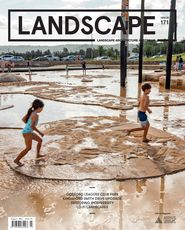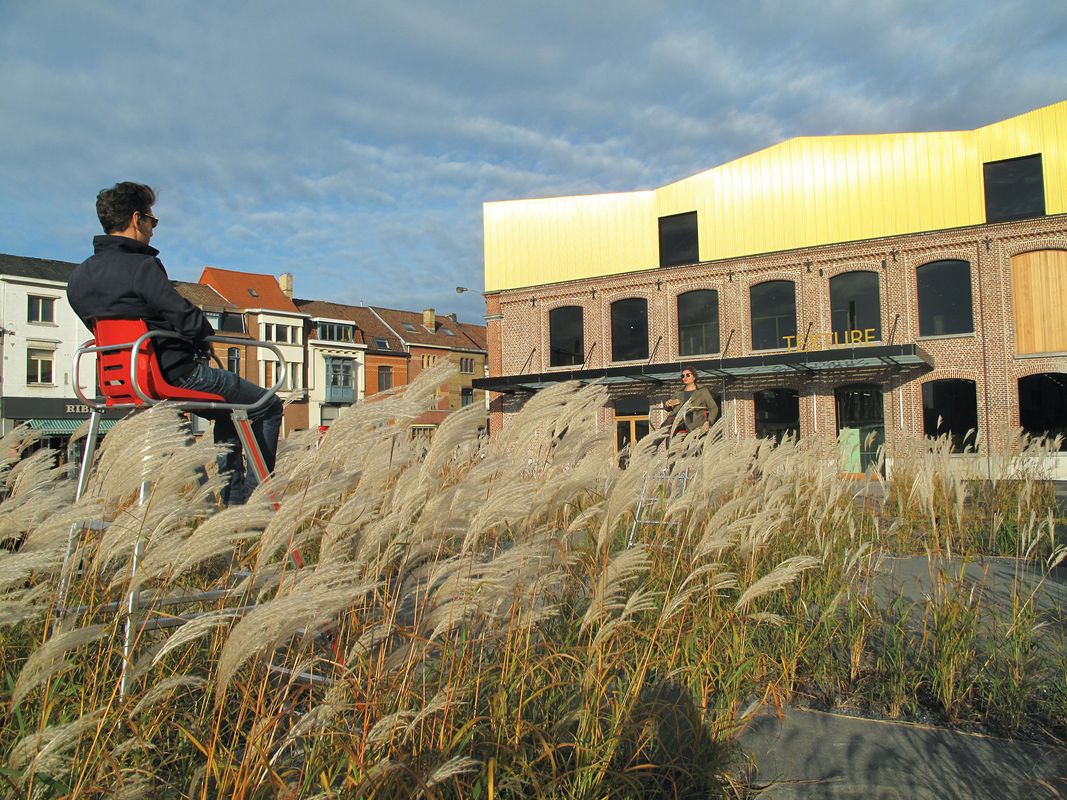Wagon Landscaping is a Paris-based practice with a DIY attitude that combines landscape architecture, construction and gardening. Founders Mathieu Gontier and François Vadepied trained at the Ecole Nationale Supérieure du Paysage de Versailles where they were encouraged to “think like gardeners.” The studios sees itself as continuing a rich hands-on tradition in French landscape architecture.
Alex Breedon: Your approach to designing and constructing landscapes appears very hands-on. Does this approach differ from that of other landscape architecture offices in France?
Mathieu Gontier: I would say that we’re not working in a “classical” landscape architectural way. This way of working really began when me and my partner, François Vadepied, started the office. We’ve always been conceptual designers, but from the very beginning we’ve been gardeners and builders too. In that way, we’re a bit different to your typical landscape architects. We design in a way that’s more minimalistic, in many senses, the way that a gardener might design. We apply this to all scales. From masterplans to small plots, we try to keep the philosophy of the gardener throughout.
Liam Mouritz: Can you explain your design process, from drawing and representing your designs to gardening and construction?
MG: We have two processes. The first involves the typical process and design stages that you will find in most landscape architecture offices, it’s a process that is really driven by government regulations, legality, and the desire for financial clarity. In the second instance, we have our own more intuitive process that is really a “Do It Yourself” approach that involves constant testing and adapting. When we’re doing it DIY we’re much more dependent on sketches, rather than any documentation or design through the computer. Even on projects with a more typical design process, we still use our DIY process, constantly modelling and altering through the project’s evolution.
Planting in its early stages of growth at Flashcode Garden.
Image: Wagon Landscaping
A labyrinth of waving grasses recalls the industrial flax production fields that once lined the city’s Leie river.
Image: Wagon Landscaping
LM: How do you mix different projects and scales, while keeping some philosophical consistency in your approach?
MG: It’s hard, because generally business culture and clients want you to be a specialist. But when you have a gardener’s philosophy, when you’re seriously considering a site, you can’t have an automatic answer. We don’t really have pre-considered solutions, which allows us to be more open and attentive to new ways of approaching things. I think this really helps us transcend project scales, from small gardens to large territories.
AB: Let’s talk about your masterplanning work. Typically, one would say, the bigger the project, the more expensive and complicated it is. How do you approach designing big sites when the budget is small?
MG: A good example for us is Archstoyanie Park in Russia where I think we produced a great project with very little money. This was really about having a good reading of the site. What we’d hoped to do was to try and re-ignite some landscape, agricultural and construction knowledge that had disappeared from the area since
the Perestroika.
We developed an open-air garden museum, just using simple agricultural machinery and techniques. Using local people’s tractors and crop harvesting equipment we cut axial paths to structure and organize movement and create landscape experiences through fields, meadows and forest areas. We also enhanced different “ambient zones,” cutting the understory of forests using a whole manner of local equipment from ride-on mowers to standard gardening shears. You can do a lot with little money, if you just focus on the field of “maintenance.” You can be really active and influential on a very large scale. Just by cutting grass, you can build a whole project from that – a whole park in fact!
When we were doing our first site visit and our first sketches, we were not just looking at plants and landscapes, we were also looking for people to help us; community groups, interested people and the caretakers of these spaces. All of these people can really help to make a project economical and efficient. It’s about bringing a site, a landscape and the people around it all together – this is what defines a project. In a way, this whole project was about creating connections between different groups of people.
At Archstoyanie Park, an abandoned agricultural zone has been transformed into an experimental and constantly evolving park-as-open-air-museum.
Image: Wagon Landscaping
The design for Archstoyanie Park curates natural processes with a focus on the building, maintaining and gardening of the planting on site over a 10-year period.
Image: Wagon Landscaping
AB: What other projects really emphasize this connection between people, site and building communities?
MG: Jardin des Joyeux, outside of Paris, is a great example. The client called us after the ongoing degradation of a big car parking lot. Originally, the lot was a big issue for the client; it was hard to manage and young people would use it to do burnouts with their cars and motorbikes. So, in a moment of passion the client destroyed the concrete with a jackhammer. They then called us and said, “We have a big problem, we’ve got all this rubble and 30,000 euros, can you help us?” We told them that if we removed the rubble, all the money would be gone. So, our idea was to leave everything on site, bring in some soil, seeds and see what we could make of it. In the end it really worked and there is a very unique garden there now. The project ended up being about 25 euros per square metre, it’s really not much.
We are constantly surprised by people’s positive reaction to the garden. Just after we’d finished constructing the project, two local people came up to us saying “When will they finally do something with this site?” not knowing we had just completed the design for it. We explained to them that this was the design and that it might take time to really show. We later found out they really fell in love with the garden as it grew and now they are quite protective of it.
AB: Your work appears to challenge traditional landscape aesthetics. What are your thoughts on beauty in design?
MG: Our approach is to explain that gardens take a long time to look beautiful, long after the designer has left. Because of this, with the Jardin des Joyeux, we decided that we would also maintain it. We would go five times a year to weed and maintain the garden. It was also a great time to catch up with the client, government maintenance teams and local people and exchange ideas about the garden’s future and adjust our maintenance regime.
Many of our projects are tests of economy and beauty. We tell the client that we will invest less money across a larger area and work with rough, second-hand materials. In these areas, we work in an ecologically dynamic way, where we plant smaller plants, garden more and embrace a longer growing time. Then, in a few small areas, we will spend more on a few nice details to give some richness to the project and to show that it’s “clean.” This contrast really works. It’s important for us to work with the client to prioritize a few expensive areas, rather than spreading it out equally. The result is often better this way.
Jardin des Joyeux transformed an abandoned and derelict car park in Aubervilliers outside of Paris into a resilient and low-tech garden that recycled the asphalt and concrete on site.
Image: Yann Monel
LM: How do you engage with large questions around the impacts of increasing inequality or the climate crises?
MG: With regards to the social aspect, it’s very simple. We try to be on site and talk to real people rather than being stuck in big meetings in an office. That’s what we love about “site.” When you have a tool in your hand, we’re all on the same level. We also like to go from sketch to building very quickly, to avoid bureaucracy when you should just be on site making it happen.
On climate change, we focus on adapting our way of planting to a rapidly changing environment. We’ve changed our approach dramatically, even from ten years ago. Now, we’re experimenting with seeding non-endemic plants on many of our projects to see what will happen.
We are explaining to clients that this is all a big experiment, because we don’t know what will happen exactly with climate change. We know to some degree what will happen, but that doesn’t mean that it’s deterministic. Therefore, our design process shouldn’t be deterministic either. We must remind ourselves that we don’t know everything and we must embrace a constant state of experimentation.
To read the first part of this interview series on lofi-landscapes – a discussion with David Godshall of Los Angeles and San Francisco-based practice Terremoto – go here.
Source

Practice
Published online: 5 Nov 2021
Words:
Alex Breedon,
Liam Mouritz
Images:
Wagon Landscaping,
Yann Monel
Issue
Landscape Architecture Australia, August 2021























